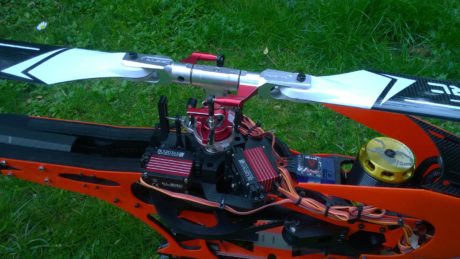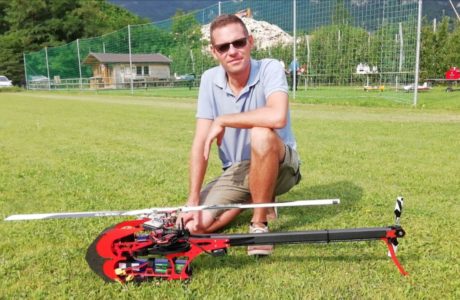
With the technological support and the consulting by Poggi Trasmissioni, Gianluca Sacco, electromechanical engineer, has designed and implemented Crotalus 600, a model of radio-controlled helicopter springing from two years of studies and tests.
«A very complicated adventure». So Gianluca Sacco defined the idea of creating and constructing a helicopter, Crotalus 600, which took off thanks to the technical contribution and consulting by Poggi Trasmissioni. «I have attended the dynamic modelling world for several years and I have always been fond of all that can be radio controlled remotely – the engineer started telling – The radio controlled helicopter was a natural evolution linked with my job as avionic mechanical technician on helicopters for military use». Notoriously, in the field of radio-controlled models, the helicopter is complicated from the point of view of piloting and even more of maintenance profile: «Approaching this new world was not easy but the expertise in aeronautical ambit gained through my job has allowed me to overcome the initial difficulties – Sacco ended – The will of engaging in the design and implementation of this model has matured in time, perhaps because what was on trade has never fully satisfied me, maybe because I really desired to construct something mine that could fly off».
From the idea to the design
The development of the design that has led to the construction of Crotalus 600 helicopter needed years of researches and tests and was articulated in more phases: the first step concerned the study of suitable programmes for the graphic design (Autocad). Afterwards they implemented a NC machine able to translate graphic lines into real objects. «Designing a helicopter features endless difficulties, often they are not all calculable because the variables at stake are manifold and we cannot define all of them priori.  The way I chose was starting developing the project and facing criticalities as soon as they aroused – Sacco explained– I established the general sizes, the number of rotors’ revolutions, the type of electric power supply, motors, power transfer modalities, static and dynamic balancing etc. The important element worth understanding is the helicopter is a machine based on very precise static and dynamic balances, before taking a design decision we must be sure of it because any successive modification determines in cascade the review of the helicopter in its whole». The main hindrance was inherent to the study of the necessary powers as well as the transfer method of such powers to rotor parts. «I decided exploiting the technology of transmission belts and pulleys and, to size components, I used the data sheet Poggi Trasmissioni makes available on the internet site –Sacco underlined- I preferred this company because it can boast sound experience in the market of mechanical transmission components. The team, with extreme professionalism and willingness, supported me in the design development and supplied me, fully free, with the belts with the specifications I had demanded for the execution of the design prototyping, as well as other useful tools to accomplish the helicopter». Bologna company’s contribution was then essential to construct this small model of flying machine. «I designed first the profiles of belts’ teeth, then the pulleys with the same pitch and with a number of correct teeth to achieve the number of rotors’ revolutions established in the preliminary design phase – the engineer showed – At this stage, it was necessary to cut the whole by using the NC machine previously implemented. The bending radii of teeth hindered me as they are very small and consequently I had the need of using very small and delicate milling cutters. The precision of the NC machine, high-quality reliable components and suitable tools allowed me to achieve a highly satisfactory final result, from both the aesthetical and mechanical point of view. The confirmation arrived when I had to couple, first statically, belts with pulleys (belt and pulley have the same profiles, then the coupling proved to be perfect), successively dynamically, when I assessed no tooth loss during the entire rotary cycle. The final result was then excellent».
The way I chose was starting developing the project and facing criticalities as soon as they aroused – Sacco explained– I established the general sizes, the number of rotors’ revolutions, the type of electric power supply, motors, power transfer modalities, static and dynamic balancing etc. The important element worth understanding is the helicopter is a machine based on very precise static and dynamic balances, before taking a design decision we must be sure of it because any successive modification determines in cascade the review of the helicopter in its whole». The main hindrance was inherent to the study of the necessary powers as well as the transfer method of such powers to rotor parts. «I decided exploiting the technology of transmission belts and pulleys and, to size components, I used the data sheet Poggi Trasmissioni makes available on the internet site –Sacco underlined- I preferred this company because it can boast sound experience in the market of mechanical transmission components. The team, with extreme professionalism and willingness, supported me in the design development and supplied me, fully free, with the belts with the specifications I had demanded for the execution of the design prototyping, as well as other useful tools to accomplish the helicopter». Bologna company’s contribution was then essential to construct this small model of flying machine. «I designed first the profiles of belts’ teeth, then the pulleys with the same pitch and with a number of correct teeth to achieve the number of rotors’ revolutions established in the preliminary design phase – the engineer showed – At this stage, it was necessary to cut the whole by using the NC machine previously implemented. The bending radii of teeth hindered me as they are very small and consequently I had the need of using very small and delicate milling cutters. The precision of the NC machine, high-quality reliable components and suitable tools allowed me to achieve a highly satisfactory final result, from both the aesthetical and mechanical point of view. The confirmation arrived when I had to couple, first statically, belts with pulleys (belt and pulley have the same profiles, then the coupling proved to be perfect), successively dynamically, when I assessed no tooth loss during the entire rotary cycle. The final result was then excellent».

A last interesting element concerned the choice of materials: «While I have had clear ideas since the beginning for some parts, carbon for sides and front-canopy support, I made various trials for the bearing support and mechanical structure. At the end, I decided using a material called POMC or acetal resin charged with different graphite percentages. Material with excellent mechanical and workability specifications, it differs from aluminium. The final result was an excellent compromise between the necessary torsional rigidity for the implementation of a precise reliable machine and the indispensable elasticity to absorb vibrations, inherent element in all helicopters. At present, the model I have created is in flight testing phase to assess mechanical stresses and make eventual modifications».
Deep roots in the territory and international approach
Poggi Trasmissioni Meccaniche S.p.a. stems in 1958 from the commitment and the dedication of Pierluigi Poggi and today the company is managed by his 3 sons. Specialized in the production of pulleys, right angle gearboxes and other solutions in the ambit of transmission parts, such as toothed and trapezoidal belts, it produces fixing elements, couplings, sprockets and baseplates for electric motors. For over 60 years, it has been appreciated in more than 40 Countries in the world for its innovative and customized approach. The array of forefront services proposed by Poggi is the fruit of unceasing researches and experimentations, of an accurate design and manufacturing course that assures an innovative, certified and proudly made in Italy product.



